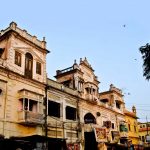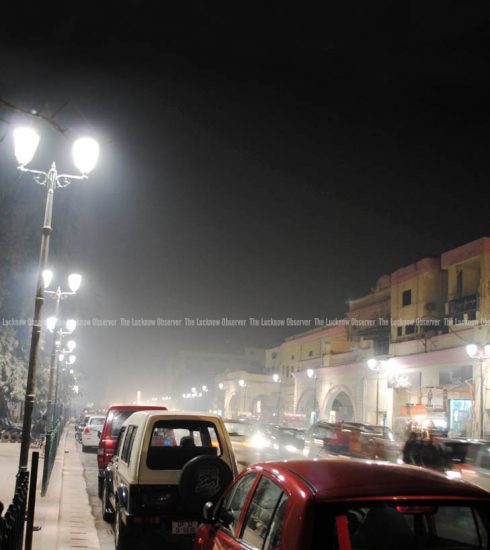Tracing Aminabad
The Accolades and Achievements
Aminabad had been the geographical and social centre of the city. Aminabad is established on a mound. The slopes at a syncline to the east and north of Aminabad all lead to river Gomti. In 18th century, when the crown prince of Delhi, Sikander Shikoh got this area from nawab Asif-ud-Daula to live in, the area boasted of the old garden of Khadija Khanum, second wife of Burhan-ul Mulk, who had also built a mosque in the heart of this garden. At a distance from the mosque, Rani Jai Kunwar had erected a Hamam (Bath House) in remembrance of Khadija Khanum who was her dear friend. This mosque still exist and is known as ‘Pandain Ki Masjid’.
In the Aminabad based palace of the crown prince Sikander Shikoh poet Sheikh Qalandar Bakhsh ‘Zur’at’ also lived. He was a regular participant in the court of the Delhi loyalty and often recited his work or played cleverly with words to the amusement of courtiers. His satires in verses were enjoyed by one and all in the royal chambers.
Khayaliganj was a locality built by Bahu Begum, mother of nawab Asif-ud-Daula. On one side of this locality is Nazirabad, while on the other side is Gopaldas garden. An alley near Khayaliganj leads to kachehri road. In this alley lived Shri Gangaprasad Mishr, who was a renowned Hindi writer. Apart from his collection of stories, his famous novels include ‘Sangharsh Ke Beech’ and ‘Zeher Chand Ka’, that have been awarded by Uttar Pradesh Hindi Sansthan.
Shri Rudranarayan Sinha was a matriculate of the first batch of U.P. High School Board, established in the 19th century. His son Gopalchandra Sinha founded the All India Sanskrit Association (Akhil Bhartiya Sanskrit Parishad), the office of which is in Hazratganj, next to PMG office. In this association, Sanskrit’s invaluable scriptures are preserved in a museum.
Narayandas’ Shivala and Aminabad Kothi are the most important monuments. Shivala was built by Lala Narayandas Khatri. His son Gangaprasad Verma is one of the most eminent builder of new Lucknow. Gangaprasad was a town planner under British rule. In those times, the municipal corporation had only four spots for membership, of which two Indian and two British officers were appointed. In 1911-12, one of the two Indian member was Maharaja Khatri while the other was Babu Gangaprasad Verma.
‘Advocate’, a newspaper that inspired the independence movement was printed here. He also printed a newspaper named ‘Hindustani’, which was later managed by Pandit Kishanprasad Kaul. Kishanprasad Kaul was the writer of ‘Fir Subah Ummeed’. Gangaprasad Verma constructed an orphanage in memory of his uncle Chedilal Khatri, inaugurated on 17th January 1914 by Sir James Boston, Lt. governer of UP.
Shriram road Chauraha is an important part of Aminabad. Shriram Das Mishr ‘Vijay’ founded ‘Hindi Pracharak Mandal’ in 1936 where religious and cultural literature was published. Premchand also lived in a house at Goonge Nawab Park. Between 1927 and 1931, when he visited Lucknow as the editor of ‘Madhuri’, Aminabad was one of his abodes. Ramkrishna mission was first opened in Lucknow in 1914 near Goonge Nawab Park. Near this very same park lived ‘Patra Bukhari’ and ‘Shaukat Thanvi’. Aminabad also became the home to the veteran drama director Kunwar Kalyan Singh. In those days, Aminabad’s Gannewali gali and Bhusa-mandi were hub of tawaif (harlots). However, Bhusa-mandi also sheltered Suryakant Tripathi ‘nirala’ for a long time. During his stay in Aminabad, Nirala produced works like ‘Parimal, ‘Geetika’ and ‘Tulsidas’. Nirala used to roam in Aminabad’s Gadbadjhala. Both Premchand along with his wife Shivrani Devi, and Rameshwari Devi ‘Chakor’ resided in Marwari gali Ramteerth Pratisthan. Sunil Dutt, during his visit to Lucknow, lived in Gannewali Gali for many days. He was a worshiper and regular temple goer in Aliganj and Aminabad Hanuman Temple. Apart from them poetess Snehlata ‘Sneh’ resided in Batashewali Gali.
Suchit Mathur
(Published in The Lucknow Observer, Volume 2 Issue 14, Dated 05 May 2015)








